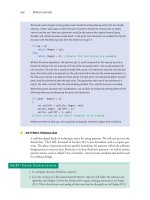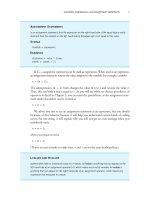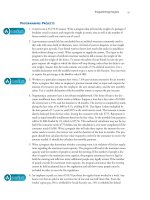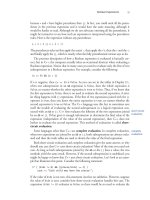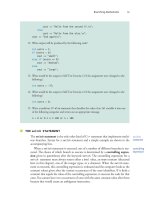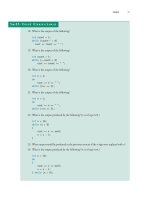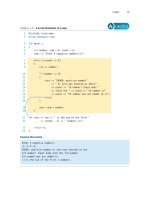Absolute C++ (4th Edition) part 7 pps
Bạn đang xem bản rút gọn của tài liệu. Xem và tải ngay bản đầy đủ của tài liệu tại đây (169.27 KB, 10 trang )
Branching Mechanisms 61
cout << "Hello from the second if.\n";
else
cout << "Hello from the else.\n";
cout << "End again\n";
12. What output will be produced by the following code?
int extra = 2;
if (extra < 0)
cout << "small";
else if (extra == 0)
cout << "medium";
else
cout << "large";
13. What would be the output in Self-Test Exercise 12 if the assignment were changed to the
following?
int extra = -37;
14. What would be the output in Self-Test Exercise 12 if the assignment were changed to the
following?
int extra = 0;
15. Write a multiway if-else statement that classifies the value of an int variable n into one
of the following categories and writes out an appropriate message.
n < 0 or 0 ≤ n ≤ 100 or n > 100
■
THE
switch
STATEMENT
The switch statement is the only other kind of C++ statement that implements multi-
way branches. Syntax for a
switch statement and a simple example are shown in the
accompanying box.
When a
switch statement is executed, one of a number of different branches is exe-
cuted. The choice of which branch to execute is determined by a controlling expres-
sion given in parentheses after the keyword
switch. The controlling expression for a
switch statement must always return either a bool value, an enum constant (discussed
later in this chapter), one of the integer types, or a character. When the
switch state-
ment is executed, this controlling expression is evaluated and the computer looks at the
constant values given after the various occurrences of the
case identifiers. If it finds a
constant that equals the value of the controlling expression, it executes the code for that
case. You cannot have two occurrences of case with the same constant value after them
because that would create an ambiguous instruction.
switch
statement
controlling
expression
62 Flow of Control
switch
S
TATEMENT
S
YNTAX
switch (
Controlling_Expression
)
{
case
Constant_1
:
Statement_Sequence_1
break;
case
Constant_2
:
Statement_Sequence_2
break;
.
.
.
case
Constant_n
:
Statement_Sequence_n
break;
default:
Default_Statement_Sequence
}
E
XAMPLE
int vehicleClass;
double toll;
cout << "Enter vehicle class: ";
cin >> vehicleClass;
switch (vehicleClass)
{
case 1:
cout << "Passenger car.";
toll = 0.50;
break;
case 2:
cout << "Bus.";
toll = 1.50;
break;
case 3:
cout << "Truck.";
toll = 2.00;
break;
default:
cout << "Unknown vehicle class!";
}
If you forget this break,
then passenger cars will
pay $1.50.
You need not place a break statement in each
case. If you omit a
break, that case continues
until a
break (or the end of the switch
statement) is reached.
Branching Mechanisms 63
Pitfall
Tip
The switch statement ends when either a break statement is encountered or the
end of the
switch statement is reached. A break statement consists of the keyword
break followed by a semicolon. When the computer executes the statements after a
case label, it continues until it reaches a break statement. When the computer encoun-
ters a
break statement, the switch statement ends. If you omit the break statements,
then after executing the code for one
case, the computer will go on to execute the code
for the next
case.
Note that you can have two
case labels for the same section of code, as in the fol-
lowing portion of a
switch statement:
case ’A’:
case ’a’:
cout << "Excellent. "
<< "You need not take the final.\n";
break;
Since the first case has no break statement (in fact, no statement at all), the effect is the
same as having two labels for one
case, but C++ syntax requires one keyword case for
each label, such as
’A’ and ’a’.
If no
case label has a constant that matches the value of the controlling expres-
sion, then the statements following the
default label are executed. You need not
have a
default section. If there is no default section and no match is found for the
value of the controlling expression, then nothing happens when the
switch statement
is executed. However, it is safest to always have a
default section. If you think your
case labels list all possible outcomes, then you can put an error message in the
default section.
F
ORGETTING
A
break
IN
A
switch
S
TATEMENT
If you forget a break in a switch statement, the compiler will not issue an error message. You
will have written a syntactically correct
switch statement, but it will not do what you intended it
to do. Notice the annotation in the example in the box entitled
switch
SS
SS
tt
tt
aa
aa
tt
tt
ee
ee
mm
mm
ee
ee
nn
nn
tt
tt
.
U
SE
switch
S
TATEMENTS
FOR
M
ENUS
The multiway if-else statement is more versatile than the switch statement, and you can use
a multiway
if-else statement anywhere you can use a switch statement. However, sometimes
the
switch statement is clearer. For example, the switch statement is perfect for implementing
menus. Each branch of the
switch statement can be one menu choice.
break
statement
default
64 Flow of Control
■
ENUMERATION TYPES
An enumeration type is a type whose values are defined by a list of constants of type
int. An enumeration type is very much like a list of declared constants. Enumeration
types can be handy for defining a list of identifiers to use as the
case labels in a switch
statement.
When defining an enumeration type, you can use any
int values and can define any
number of constants. For example, the following enumeration type defines a constant
for the length of each month:
enum MonthLength { JAN_LENGTH = 31, FEB_LENGTH = 28,
MAR_LENGTH = 31, APR_LENGTH = 30, MAY_LENGTH = 31,
JUN_LENGTH = 30, JUL_LENGTH = 31, AUG_LENGTH = 31,
SEP_LENGTH = 30, OCT_LENGTH = 31, NOV_LENGTH = 30,
DEC_LENGTH = 31 };
As this example shows, two or more named constants in an enumeration type can receive
the same
int value.
If you do not specify any numeric values, the identifiers in an enumeration type
definition are assigned consecutive values beginning with
0. For example, the type
definition
enum Direction { NORTH = 0, SOUTH = 1, EAST = 2, WEST = 3 };
is equivalent to
enum Direction { NORTH, SOUTH, EAST, WEST };
The form that does not explicitly list the int values is normally used when you just
want a list of names and do not care about what values they have.
Suppose you initialize an enumeration constant to some value, say
enum MyEnum { ONE = 17, TWO, THREE, FOUR = -3, FIVE };
then ONE takes the value 17; TWO takes the next int value, 18; THREE takes the next
value,
19; FOUR takes -3; and FIVE takes the next value, -2. In short, the default for the
first enumeration constant is
0. The rest increase by 1 unless you set one or more of the
enumeration constants.
Although the constants in an enumeration type are give as
int values and can be
used as integers in many contexts, remember that an enumeration type is a separate
type and treat it as a type different from the type
int. Use enumeration types as labels
and avoid doing arithmetic with variables of an enumerations type.
■
THE CONDITIONAL OPERATOR
It is possible to embed a conditional inside an expression by using a ternary operator
know as the conditional operator (also called the ternary operator or arithmetic
if
). Its
enumeration
type
conditional
operator
Branching Mechanisms 65
Self-Test Exercises
use is reminiscent of an older programming style, and we do not advise using it. It is
included here for the sake of completeness (and in case you disagree with our program-
ming style).
The conditional operator is a notational variant on certain forms of the
if-else
statement. This variant is illustrated below. Consider the statement
if (n1 > n2)
max = n1;
else
max = n2;
This can be expressed using the conditional operator as follows:
max = (n1 > n2) ? n1 : n2;
The expression on the right-hand side of the assignment statement is the condi-
tional operator expression:
(n1 > n2) ? n1 : n2
The ? and : together form a ternary operator know as the conditional operator. A con-
ditional operator expression starts with a Boolean expression followed by a
? and then
followed by two expressions separated with a colon. If the Boolean expression is
true,
then the first of the two expressions is returned; otherwise, the second of the two
expressions is returned.
16. Given the following declaration and output statement, assume that this has been embedded
in a correct program and is run. What is the output?
enum Direction { N, S, E, W };
//
cout << W << " " << E << " " << S << " " << N << endl;
17. Given the following declaration and output statement, assume that this has been embedded
in a correct program and is run. What is the output?
enum Direction { N = 5, S = 7, E = 1, W };
//
cout << W << " " << E << " " << S << " " << N << endl;
conditional
operator
expression
66 Flow of Control
Loops
It is not true that life is one damn thing after another—It’s one
damn thing over and over.
Edna St. Vincent Millay,
Letter to Arthur Darison Ficke, October 24, 1930
Looping mechanisms in C++ are similar to those in other high-level languages. The
three C++ loop statements are the
while statement, the do-while statement, and the
for statement. The same terminology is used with C++ as with other languages. The
code that is repeated in a loop is called the loop body. Each repetition of the loop body
is called an iteration of the loop.
■
THE
while
AND
do-while
STATEMENTS
The syntax for the while statement and its variant, the do-while statement, is given in
the accompanying box. In both cases, the multistatement body syntax is a special case
of the syntax for a loop with a single-statement body. The multistatement body is a sin-
gle compound statement. Examples of a
while statement and a do-while statement are
given in Displays 2.4 and 2.5.
S
YNTAX
FOR
while
AND
do-while
S
TATEMENTS
A
while
S
TATEMENT
WITH
A
S
INGLE
S
TATEMENT
B
ODY
while (
Boolean_Expression
)
Statement
A
while
S
TATEMENT
WITH
A
M
ULTISTATEMENT
B
ODY
while (
Boolean_Expression
)
{
Statement_1
Statement_2
.
.
.
Statement_Last
}
2.3
while and
do-while
compared
Loops 67
A
do-while
S
TATEMENT
WITH
A
S
INGLE
-S
TATEMENT
B
ODY
do
Statement
while (
Boolean_Expression
);
A
do-while
S
TATEMENT
WITH
A
M
ULTISTATEMENT
B
ODY
do
{
Statement_1
Statement_2
.
.
.
Statement_Last
} while (
Boolean_Expression
);
Display 2.4 Example of a
while Statement
(part 1 of 2)
1 #include <iostream>
2 using namespace std;
3 int main( )
4 {
5 int countDown;
6 cout << "How many greetings do you want? ";
7 cin >> countDown;
8 while (countDown > 0)
9 {
10 cout << "Hello ";
11 countDown = countDown - 1;
12 }
13 cout << endl;
14 cout << "That’s all!\n";
15 return 0;
16 }
Do not forget the
final semicolon.
68 Flow of Control
Display 2.4 Example of a while Statement
(part 2 of 2)
S
AMPLE
D
IALOGUE
1\
How many greetings do you want? 3
Hello Hello Hello
That’s all!
S
AMPLE
D
IALOGUE
2
How many greetings do you want? 0
That’s all!
The loop body is executed
zero times
Display 2.5 Example of a do-while Statement
(part 1 of 2)
1 #include <iostream>
2 using namespace std;
3 int main( )
4 {
5 int countDown;
6 cout << "How many greetings do you want? ";
7 cin >> countDown;
8 do
9 {
10 cout << "Hello ";
11 countDown = countDown - 1;
12 }while (countDown > 0);
13 cout << endl;
14 cout << "That’s all!\n";
15 return 0;
16 }
S
AMPLE
D
IALOGUE
1
How many greetings do you want? 3
Hello Hello Hello
That’s all!
Loops 69
The important difference between the while and do-while loops involves when the
controlling Boolean expression is checked. With a
while statement, the Boolean
expression is checked before the loop body is executed. If the Boolean expression evalu-
ates to
false, the body is not executed at all. With a do-while statement, the body of
the loop is executed first and the Boolean expression is checked after the loop body is
executed. Thus, the
do-while statement always executes the loop body at least once.
After this start-up, the
while loop and the do-while loop behave the same. After each
iteration of the loop body, the Boolean expression is again checked; if it is
true, the
loop is iterated again. If it has changed from
true to false, the loop statement ends.
The first thing that happens when a
while loop is executed is that the controlling
Boolean expression is evaluated. If the Boolean expression evaluates to
false at that
point, the body of the loop is never executed. It may seem pointless to execute the body
of a loop zero times, but that is sometimes the desired action. For example, a
while
loop is often used to sum a list of numbers, but the list could be empty. To be more spe-
cific, a checkbook balancing program might use a
while loop to sum the values of all
the checks you have written in a month—but you might take a month’s vacation and
write no checks at all. In that case, there are zero numbers to sum and so the loop is
iterated zero times.
■
INCREMENT AND DECREMENT OPERATORS REVISITED
In general, we discourage the use of the increment and decrement operators in expres-
sions. However, many programmers like to use them in the controlling Boolean expres-
sion of a
while or do-while statement. If done with care, this can work out satisfactorily.
An example is given in Display 2.6. Be sure to notice that in
count++ <= number-
OfItems
, the value returned by count++ is the value of count before it is incremented.
Display 2.5 Example of a do-while Statement
(part 2 of 2)
S
AMPLE
D
IALOGUE
2
How many greetings do you want? 0
Hello
That’s all!
The loop body
is always executed at least once.
executing
the body
zero times
70 Flow of Control
Display 2.6 The Increment Operator in an Expression
1 #include <iostream>
2 using namespace std;
3 int main( )
4 {
5 int numberOfItems, count,
6 caloriesForItem, totalCalories;
7 cout << "How many items did you eat today? ";
8 cin >> numberOfItems;
9 totalCalories = 0;
10 count = 1;
11 cout << "Enter the number of calories in each of the\n"
12 << numberOfItems << " items eaten:\n";
13 while (count++ <= numberOfItems)
14 {
15 cin >> caloriesForItem;
16 totalCalories = totalCalories
17 + caloriesForItem;
18 }
19 cout << "Total calories eaten today = "
20 << totalCalories << endl;
21 return 0;
22 }
S
AMPLE
D
IALOGUE
How many items did you eat today? 7
Enter the number of calories in each of the
7 items eaten:
300 60 1200 600 150 1 120
Total calories eaten today = 2431
